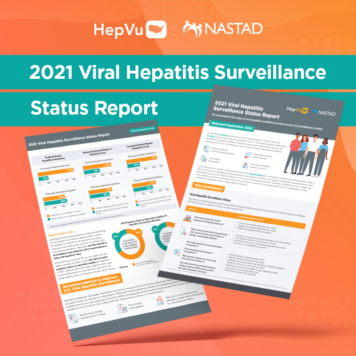Heather Bradley, PhD, is an Associate Professor of Epidemiology at the Rollins School of Public Health at Emory University and serves as HepVu Project Director.
Boatemaa Ntiri-Reid, JD, MPH is the Senior Director of Syndemic Approaches at NASTAD. In this role, she leads the integration of HIV, viral hepatitis, and drug user health into a united framework for improving outcomes across these intersecting issues.
The inaugural report released in 2022 was the first of its kind for the viral hepatitis community. What was the impetus for the first report, and now with the 2023 report available, who will find the latest insights and viral hepatitis surveillance trends over time helpful?
Heather: The reasoning behind this series of surveillance status reports is to document hepatitis B and C surveillance practices across the US, how they differ by jurisdiction, where jurisdictions are doing well, and where more resources are needed to support hepatitis surveillance activities. The baseline report was intended to measure surveillance practices prior to disbursement of 2021 CDC funding for viral hepatitis surveillance. This year, we wanted to look at how practices have changed as a result of this funding, and we will follow up on an annual basis to assess the extent to which jurisdictions have improved capacity for surveillance activities with additional investments.
The interesting thing about this report compared to baseline is that we can look at investments in the first year, how many improvements have resulted, and how much more needs to be done.
Boatemaa: There is an unprecedented effort out of the White House to fund a plan to eliminate hepatitis C domestically. Critical to that plan will be the capacity to measure our efforts to test and treat hepatitis C, as well as hepatitis B. Having a solid viral hepatitis surveillance infrastructure across our jurisdictions is necessary to measure our progress towards our elimination goals. Additionally, in last year’s report, we learned that 43% of jurisdictions have established elimination goals and even more have elimination plans in progress, this year, that increased to 70%.
Knowing our surveillance capacity at the local level and then determining what additional resources are needed is essential to measuring our local elimination progress. Everyone—from the person at the local health department, to the state health department, the territorial health department, at CDC, and all the way up to the White House—will find this year’s report important to understanding how we can tackle hepatitis elimination in our nation.
This year’s report on U.S. viral hepatitis surveillance efforts in 2022 expands upon last year’s inaugural look at capacity, elimination goals, data dissemination, and dedicated staffing, all of which speak to varying levels of jurisdiction funding and resources. What new or different surveillance efforts did this year’s report look at and what did you find surprising or stood out for elimination strategies moving forward?
Heather: Looking at the findings from the baseline report gave us good ideas on where we wanted to dig deeper, and we asked some new questions in this year’s survey. The new report is not simply a comparison of the baseline to 2022 practices. We asked about a few things in a little more depth. One thing that really stood out for me is that last year we asked about whether jurisdictions had viral hepatitis elimination strategies, and whether they had been made public. This year we added a few questions to examine this in more detail.
What became clear is that many jurisdictions do have elimination plans, but many of them are neither being implemented nor monitored. We saw that only 3% of jurisdictions could implement their elimination strategy through using the earmarked CDC funding alone. That really speaks volumes to going a little deeper on this issue, not just asking if states and cities have a plan, but also whether they able to move forward with that plan.
Boatemaa: While jurisdictions reported that the funding they are receiving from CDC is not sufficient to get them towards their elimination goals, they also reported that the funding resulted in increased capacity. That means that if you not only provide the funding but provide the resources—including the technical assistance that they are getting from their CDC regional teams, as well as NASTAD—that the work can be done. In addition to talking about increased surveillance capacity across the board, we also saw that there was an increased capacity around data matching and producing annual surveillance summaries.
The level of capacity still is not where we need it to be and is unlikely to increase significantly going into next year unless the funding that is going to CDC for viral hepatitis increases. The 14 jurisdictions that were funded prior to this new award (that expanded funding into 59 jurisdictions), have continued to show more significant surveillance capacity than their counterparts who have now been funded under the new award. These newer jurisdictions are funded at half or even less than what those previous 14 jurisdictions were getting. While jurisdictions have been able to increase their capacity to do surveillance work, we need to recognize that we’re not where we could be if we had identified and prioritized more resources to get jurisdictions up to core surveillance.
Now with the first look at year-over-year data on viral hepatitis surveillance efforts available, what do we need to continue doing as a nation, and at the local level, to take the biggest strides in reaching our viral hepatitis elimination goals? What do we need to change?
Boatemaa: Although we are early into our assessment of where the jurisdictional hepatitis surveillance programs lie, in terms of their capacity and what they have been able to do, we are finding that significant strides can be made even with limited resources. This speaks to the fact that if we invest in core surveillance, it will be worth the increase in funding.
We have to get jurisdictions to a place where they can independently, or with partners, establish their prevalence estimates, be able to update those prevalence estimates, to collect demographic data, analyze their demographic data to identify where they should be prioritizing their resources, and find which populations are most impacted by their viral hepatitis epidemic. That is critical to reduce viral hepatitis cases. We have identified that making this commitment and investing those resources will give us a return on our investment.
There is a wealth of expertise that exists within our health departments, through our hepatitis surveillance programs as well as our broader infectious disease workforce. Despite it being a small workforce, it is a mighty workforce, and they have demonstrated by their participation in these surveys just how critical they have determined it is for us to have a better understanding of hepatitis surveillance in our nation.
Heather: We did see improvements in a couple of key metrics, including the percentage of jurisdictions with at least one full-time employee dedicated to surveillance (FTE), which increased from 68% to 80% — a big jump. We saw a lot of differences in capacity between jurisdictions that did or did not have at least one FTE, including the ability to produce prevalence estimates, to publish surveillance summaries, and to do core surveillance activities. Importantly, 20% of jurisdictions still do not have at least one FTE working on viral hepatitis surveillance. We need to continue building capacity, because we see that when capacity is increased these jurisdictions can perform core surveillance activities, and they are doing a lot with the limited resources that they have now.
Another important area of the report is additional information that we collected on the jurisdictions’ ability to address inequities in viral hepatitis using their data. We learned that just about half of jurisdictions had adequate data to assess and address hepatitis disparities by race and ethnicity. We know from our own data and other data there are large disparities, particularly in hepatitis C, by race and ethnicity. Only about half of the jurisdictions had adequate data to look at and act on health disparities by urbanicity. We want jurisdictions to be able to make comparisons in burden of disease by characteristics like race/ethnicity and urbanicity so that they know how to target resources. The two areas that we must move forward in are increasing staff capacity and continuing to improve the quality of demographic data so jurisdictions can assess and act on health disparities.
Given the results of this study, what does this report signify for the future of viral hepatitis surveillance?
Heather: We have seen some exciting things coming out of the White House in terms of viral hepatitis elimination. We have also seen some exciting things come out of various states about viral hepatitis elimination. There is political will, at many levels, to eliminate hepatitis C and to reduce the burden of hepatitis B. But without basic measures of burden of disease, it is going to be difficult to know when we have done that or how close we are to doing that. We must continue talking about the need for improved surveillance capacity every time we talk about implementing an elimination strategy. To make the best use of scarce resources in this setting, we are going to need to know how to target those resources. We need to have a baseline understanding of the burden of disease across various populations, and we need to be able monitor success over time.
We all share a commitment to making the best use of federal dollars allocated in this area. The responsible thing to do would be to have a good measurement system in place so that we know how to allocate those dollars and to monitor progress as we spend them.
Boatemaa: We are moving in the right direction, but we have more investments to make in hepatitis surveillance as we continue training up the existing and new workforce. That workforce now has increased capacity to address the hepatitis burden within their jurisdiction. They have gained capacity to do broader infectious disease work. If you can do hepatitis surveillance, you can really do infectious disease surveillance across the board. So by investing in hepatitis surveillance, we are not only building up the hepatitis surveillance workforce, but we are also building up our infectious disease workforce in individual jurisdictions as well as nationally. That is a worthwhile and important investment.



